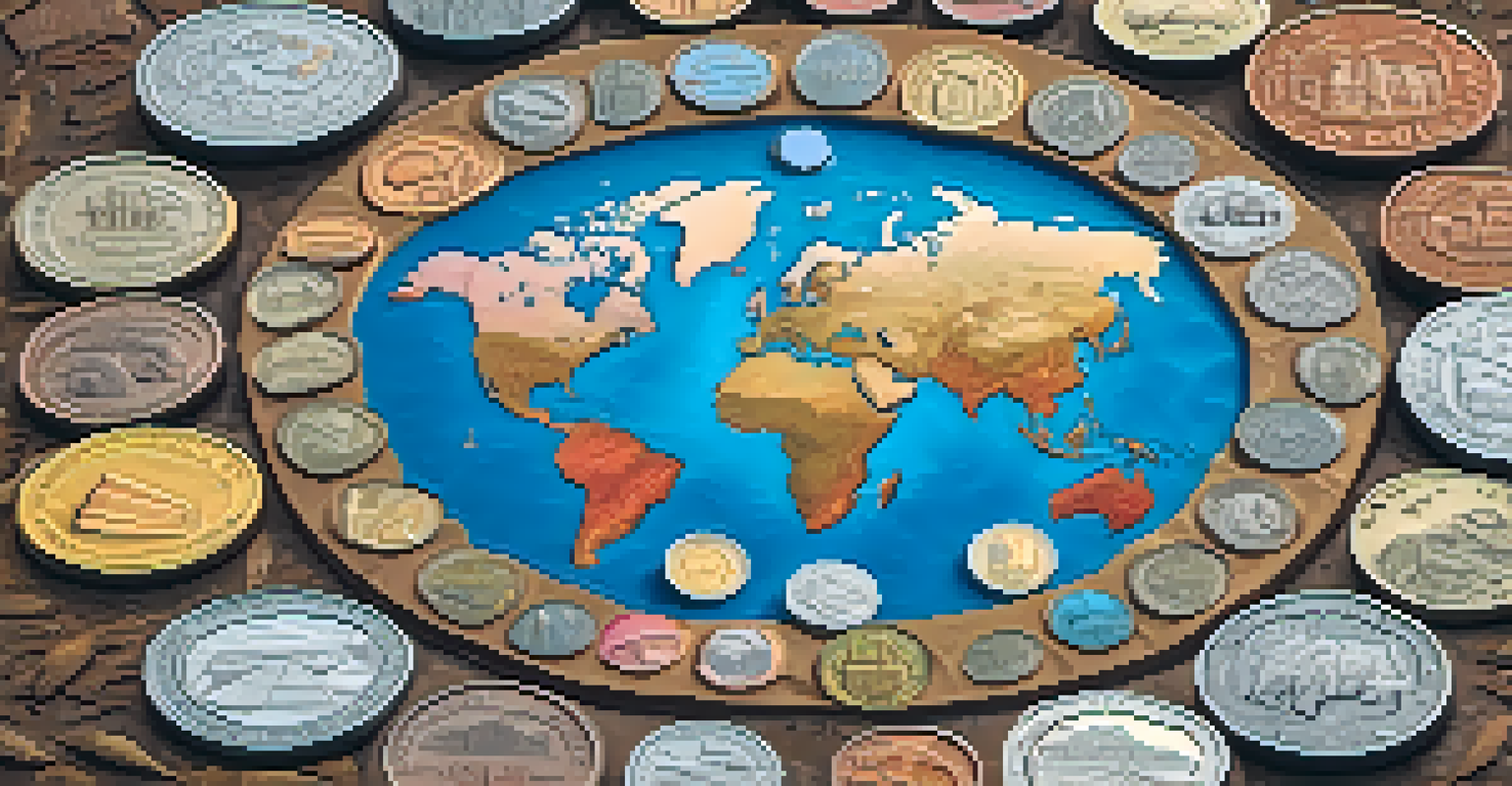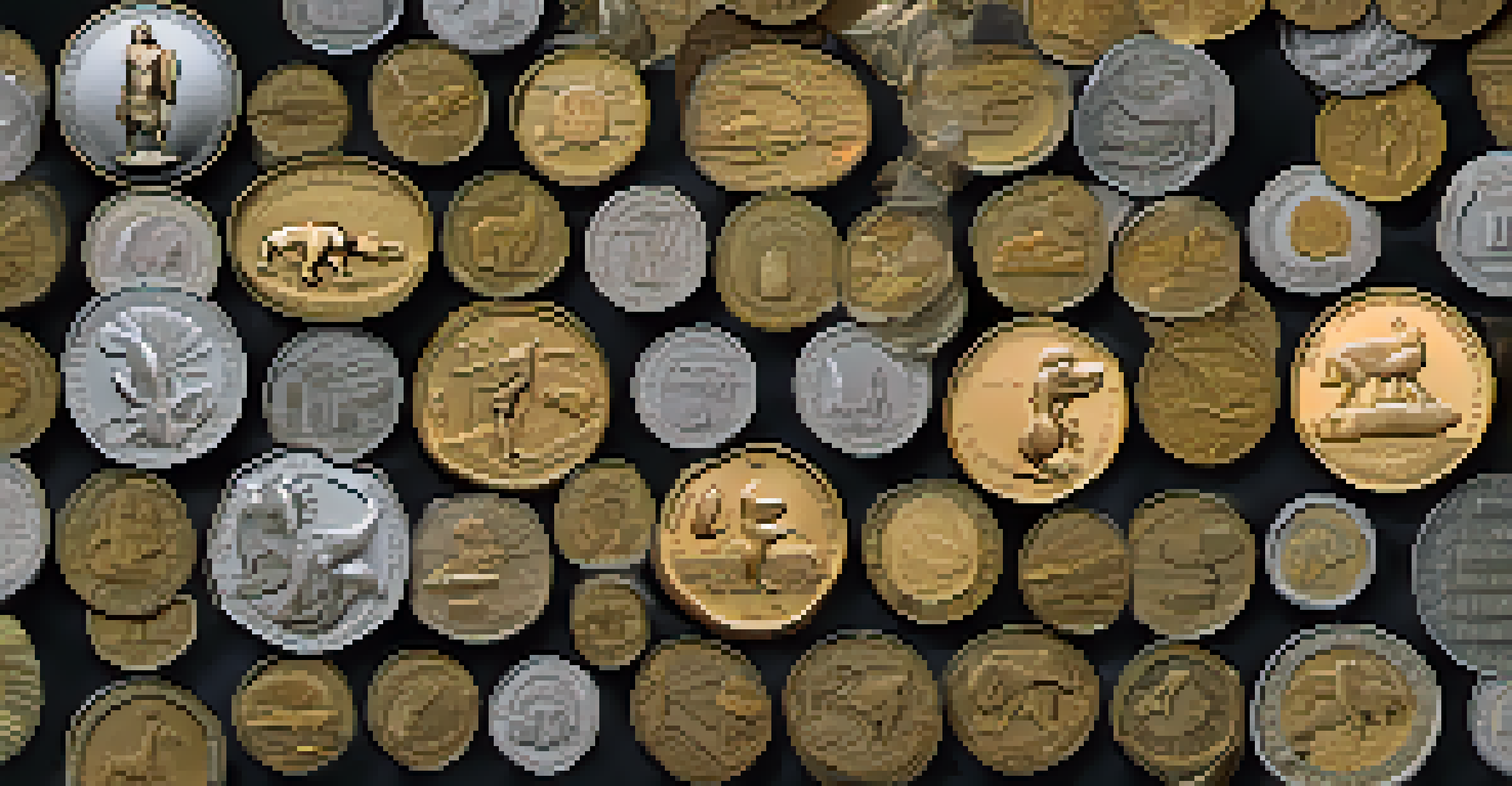The Influence of Historical Events on Coin Design

The Role of Coins in Reflecting National Identity
Coins have long served as a canvas for national identity, often showcasing symbols, leaders, and events that resonate with a nation’s history. For instance, the U.S. quarter features George Washington, a figure that represents the country's founding and values. This connection between coin design and national pride helps to instill a sense of belonging among citizens.
Coins are a tangible representation of a nation’s identity and values.
Moreover, coins can reflect cultural values and societal changes. The introduction of the Euro introduced designs that celebrated unity among diverse European nations, emphasizing shared history and collaboration. Such designs can foster a collective identity, bridging gaps between differing cultures.
In essence, the design of coins becomes a narrative, telling the story of a nation's evolution and aspirations. As historical events unfold, coins capture these moments, allowing future generations to connect with their heritage through tangible symbols.
Commemorative Coins: Celebrating Significant Events
Commemorative coins serve a special purpose, often created to honor important historical milestones or figures. For instance, the U.S. Mint releases special editions to celebrate anniversaries, like the 100th birthday of the National Park Service. These coins not only recognize achievements but also educate the public about these pivotal moments.

The design of these coins often includes imagery and inscriptions that tell a story. For example, the 50th anniversary of the Moon landing was marked with a coin that displayed an astronaut and the lunar surface, capturing the spirit of exploration and human achievement. Such designs evoke emotions and memories, making them beloved by collectors.
Coins Reflect National Identity
Coins serve as a canvas for national pride, showcasing symbols and leaders that resonate with a nation's history.
Through commemorative coins, we see how history is preserved in a tangible form. They remind us of our past and inspire future generations to appreciate and learn from it.
Iconic Figures: The Influence of Leaders on Coinage
Leaders and influential figures often dominate coin designs, shaping public perception and historical narrative. For example, many countries feature their monarchs or presidents on coins, reflecting their authority and significance in society. This practice not only honors these individuals but also solidifies their legacy in history.
The story of a nation is reflected in its coinage, capturing the essence of its history and culture.
The depiction of leaders on coins can also be a reflection of a nation’s political climate. In times of celebration, coins might feature beloved figures, while in times of upheaval, designs may shift to represent new leadership or values. This dynamic nature showcases how coins can act as snapshots of a nation's evolving identity.
Ultimately, the portrayal of leaders on coins serves to connect citizens with their government and history. These figures become symbols of national pride and continuity, allowing people to engage with their heritage.
Cultural Symbols: Coins as Vessels of Heritage
Cultural symbols play a significant role in coin design, often reflecting a nation’s traditions, myths, and art. For instance, the use of indigenous motifs or historical landmarks can convey a deep sense of cultural pride. These elements not only enhance the aesthetic appeal of coins but also serve to educate the public about their heritage.
When coins feature cultural symbols, they help to preserve history and promote awareness of diverse traditions. For example, Australia’s coins often showcase native animals and plants, celebrating the country’s unique biodiversity. This serves not just as a design choice but as a commitment to honoring the environment and culture.
Commemorative Coins Preserve History
These special coins honor significant events and figures, educating the public while evoking emotions and memories.
In this way, coins become more than just currency; they are artifacts of cultural identity. They tell stories that resonate with citizens, encouraging a deeper appreciation for their roots.
Economic Changes and Their Impact on Coin Design
Economic shifts often lead to changes in coin design, reflecting the needs and values of the time. For example, during periods of inflation, countries may redesign coins to include more durable materials or different denominations. This adaptability highlights how coin design is not just about aesthetics but also practicality in response to economic conditions.
Additionally, the introduction of new technologies can influence how coins are produced and designed. With advancements in minting techniques, coins can have more intricate designs and security features. This evolution ensures that currency remains relevant and secure in an increasingly digital world.
Ultimately, the interplay between economics and coin design reveals a responsive relationship. As societies evolve and economies fluctuate, coins adapt, mirroring the state of the nation.
The Influence of Global Events on Coin Design
Global events, such as wars or international celebrations, often have a profound effect on coin design. Coins may be minted to commemorate such events, serving as a reminder of shared history and collective experiences. For instance, coins released during the Olympics highlight national pride and global camaraderie, celebrating athletes and their achievements.
Moreover, global crises can lead to significant changes in coin design. For example, during World War II, many countries altered their coinage to reflect wartime efforts, often incorporating symbols of resilience or unity. These designs resonate deeply with citizens, capturing the spirit of the times.
Economic Changes Shape Coin Design
Shifts in the economy lead to adaptations in coin design, reflecting practical needs and societal values over time.
In essence, global events shape coin design as much as national ones do. They create a shared language of history and identity, transcending borders and fostering a sense of unity among people.
Modern Trends in Coin Design and Historical Influence
Today, coin design continues to evolve, influenced by historical contexts while integrating modern aesthetics. Designers often draw inspiration from past coins, reinterpreting classic designs with contemporary twists. This blending of old and new allows for a rich dialogue between history and modernity.
Furthermore, social movements and changing values are increasingly reflected in coin designs. For example, recent releases may highlight themes of diversity, environmental conservation, or social justice, aligning with current global conversations. This trend showcases how coins remain relevant in addressing contemporary issues.

Ultimately, modern trends in coin design remind us that history is never static; it’s a living narrative that continues to influence the present. As we look to the future, coins will likely evolve further, embodying the complexities of society while honoring the past.